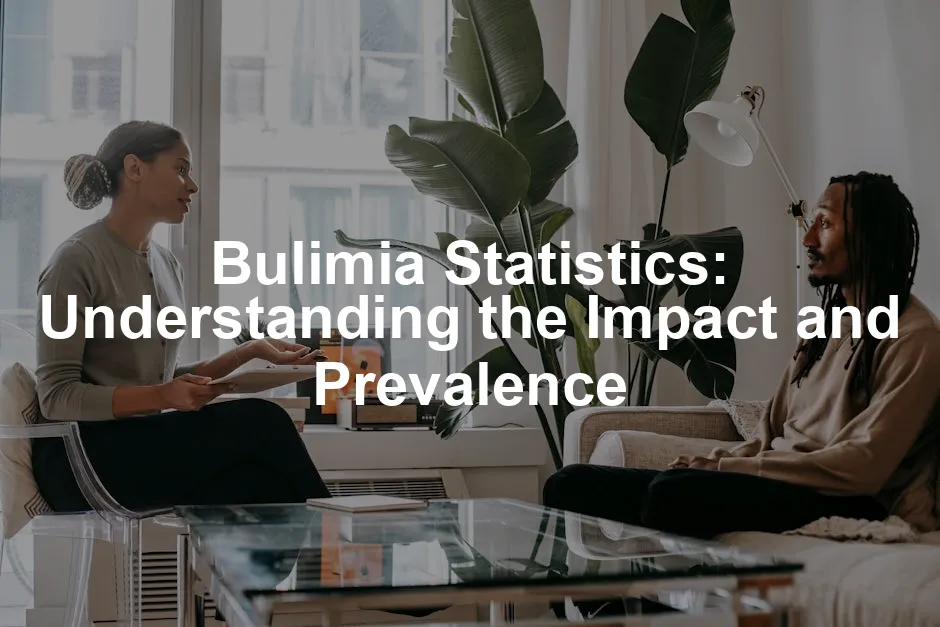Introduction
Bulimia nervosa, or simply bulimia, is a serious eating disorder that deserves our attention. It involves episodes of binge eating, where individuals consume large quantities of food in a short time. This is often followed by compensatory behaviors, such as self-induced vomiting, excessive exercise, or fasting, to prevent weight gain. The struggle with bulimia goes beyond just food; it intertwines with emotional and psychological challenges.
Understanding bulimia statistics is crucial for raising awareness, informing effective treatment options, and shaping preventive measures. Statistics provide insights into the prevalence and impact of this disorder, helping us recognize its seriousness and the need for proper support. They also guide healthcare professionals in developing targeted interventions.
This article aims to explore various facets of bulimia statistics, including prevalence rates, demographic breakdowns, and co-occurring mental health conditions. We’ll also delve into treatment statistics and the societal factors that may influence these numbers. By understanding bulimia through its statistics, we can foster awareness and empathy for those affected.
As we dive into these numbers, let’s keep an open mind. The statistics not only reflect individual struggles but also highlight a broader societal issue. Addressing bulimia is not merely about numbers, but about understanding the lives behind those numbers and promoting a supportive environment for recovery.

To help you along the journey of understanding and self-care, consider enhancing your wellness routine with a Self-help journal. It can be a great tool for reflection and processing emotions, which are crucial in understanding your relationship with food.
Understanding Bulimia Nervosa
Definition and Symptoms
Bulimia nervosa is characterized by cycles of binge eating followed by compensatory behaviors. Unlike anorexia, individuals with bulimia may maintain a normal weight, but they often experience severe anxiety regarding body image. Common symptoms include:
- Binge eating: Consuming large amounts of food in a short period, often accompanied by feelings of loss of control.
- Purging: Engaging in self-induced vomiting, using laxatives, or excessive exercising to mitigate weight gain.
- Preoccupation with body image: Intense dissatisfaction with body size and shape, leading to distress.
- Secrecy: Hiding eating behaviors and feelings due to shame or guilt.
Bulimia differs from other eating disorders, such as anorexia and binge eating disorder. While anorexia involves severe restriction of food intake and often results in significant weight loss, binge eating disorder is characterized by recurrent binge eating without compensatory behaviors. Understanding these distinctions is vital for accurate diagnosis and treatment.
Recognizing the symptoms of bulimia is crucial for early intervention. If you or someone you know exhibits these behaviors, it’s important to seek professional help. The road to recovery starts with understanding and addressing the disorder head-on.

For those looking to embrace a healthier lifestyle, check out this Mindful Eating: A Guide to Rediscovering a Healthy and Joyful Relationship with Food by Jan Chozen Bays. It’s a delightful read that encourages a healthier perspective on food, making every meal an opportunity for joy rather than guilt.
Causes and Risk Factors
Bulimia nervosa is a complex disorder influenced by various factors. Psychological, biological, and sociocultural elements all play a role in its development.
Psychologically, individuals with bulimia often struggle with low self-esteem and body dissatisfaction. Many experience anxiety and depression, making them vulnerable to unhealthy coping mechanisms. The pressure to conform to societal beauty standards can amplify these feelings, leading to disordered eating patterns.
Biologically, genetics may contribute to the risk of developing bulimia. Research suggests that family history plays a significant role. Individuals with relatives who have eating disorders are at a higher risk. Hormonal changes, especially during puberty, can also trigger the onset of bulimia.
Sociocultural factors are equally impactful. Media portrayal of thinness as an ideal body type fosters unrealistic expectations. Cultural pressures can create a toxic environment where weight loss is prized above health. This often pushes individuals toward extreme measures to control their weight.
Certain personality traits are commonly linked to bulimia. Perfectionism is a significant factor. Those who strive for flawlessness may find themselves trapped in a cycle of bingeing and purging when faced with perceived failures. Neuroticism, characterized by emotional instability, can also increase the likelihood of developing bulimia. Individuals high in neuroticism may react more intensely to stress, leading them to seek comfort in food.
Understanding these causes and risk factors is crucial for prevention and treatment strategies. By addressing the psychological, biological, and sociocultural aspects of bulimia, we can better support those affected and help them find healthier coping mechanisms.

If you’re looking for a practical approach to recovery, consider picking up Goodbye Ed, Hello Me by Jenni Schaefer. It’s a powerful guide for anyone looking to break free from the chains of an eating disorder and embrace life fully.
Prevalence of Bulimia Statistics
General Prevalence
Bulimia nervosa is a significant public health concern, with notable prevalence rates in various demographics. In the general population, approximately 1.5% of women and 0.5% of men experience bulimia at some point in their lives. These figures illustrate the stark contrast in prevalence between genders. Women are more likely to develop bulimia, likely due to societal pressures regarding appearance.
Age plays a critical role in the prevalence of bulimia. The disorder commonly emerges in adolescence, particularly among young women. Studies indicate lifetime prevalence rates of bulimia nervosa among adolescents are concerning, with figures ranging from 2.0% to 5.4% among girls. This demographic is particularly vulnerable to body image issues and societal expectations.
Ethnic differences also exist in the prevalence of bulimia. Research indicates that ethnic minority youth may experience higher rates of bulimia. For instance, among ethnic minority females, the prevalence can reach 5.1%, while it is about 2.3% among males. These statistics highlight the need for culturally sensitive approaches to prevention and treatment. Additionally, understanding the statistics of eating disorders in race can provide further insights into this issue.
Examining the statistics of eating disorders across different racial groups can shed light on the prevalence and impact of bulimia within these communities. statistics of eating disorders in race

Prevalence Among Specific Populations
Adolescents
In adolescents, the prevalence of bulimia is alarmingly high. Recent studies show that the rates among girls aged 13 to 18 are increasing. The transition to young adulthood sees a rise in cases, with prevalence estimates between 2.0% to 5.4%. This increase can be attributed to heightened societal pressures related to body image and weight, as well as the impact of social media.
Adolescents face unique challenges that contribute to the development of bulimia. Peer pressure, academic stress, and exposure to idealized body images can lead to disordered eating behaviors. It’s essential to address these factors through education and support systems that promote healthy body image and self-esteem.
By understanding the prevalence of bulimia in different populations, we can tailor our prevention efforts and resources. It’s crucial to create an environment that fosters awareness and provides support for those affected by this disorder, especially among vulnerable groups like adolescents.

For those interested in holistic approaches, consider exploring the benefits of yoga with a quality Yoga mat. It can be a wonderful way to find balance and relaxation, aiding in your journey toward recovery.
Ethnic and Gender Differences
Bulimia nervosa doesn’t discriminate, but it does show varying impacts across different genders and ethnicities. Studies reveal that ethnic minority youth often face higher rates of bulimia. For example, approximately 5.1% of girls from these backgrounds struggle with the disorder, compared to 2.3% of boys. This disparity underscores the need for tailored treatment and outreach strategies for these groups.
When we look at gender differences, bulimia is predominantly a female issue. Women are affected five times more than men, with a lifetime prevalence of 1.5% in women versus 0.5% in men. However, male cases are rising, particularly in communities where body image ideals are heavily scrutinized, such as in sports or fitness settings.
Understanding these differences is essential for addressing the unique challenges faced by various demographic groups. It helps in crafting interventions that resonate with specific cultural contexts and promote better outcomes for all individuals affected by bulimia.

If you or someone you know is struggling, consider reading Daring Greatly by Brené Brown. It addresses vulnerability and connection, which can be key in recovery and understanding one’s self-worth.
Global Perspectives
Bulimia is a global concern, but its prevalence varies significantly across countries. In Western nations, such as the U.S. and Canada, lifetime prevalence rates hover around 1.5% for women. However, in non-Western countries, awareness and reporting of bulimia are increasing, with rising prevalence rates observed. For instance, countries in the Middle East have seen a 22% increase in bulimia cases from 1990 to 2019.
This uptick may be attributed to globalization and the spread of Western beauty ideals, impacting body image perceptions worldwide. As awareness grows, so does the urgency for culturally competent treatment approaches that address these emerging trends.

Comorbidity and Mental Health Implications
Co-occurring Disorders
Bulimia nervosa frequently occurs alongside other mental health conditions. About 80.6% of individuals with bulimia experience some form of anxiety disorder. Additionally, around 70.7% also struggle with mood disorders, such as depression. This overlap can complicate diagnosis and treatment, necessitating a comprehensive approach that addresses both bulimia and any co-occurring conditions.
Substance use disorders are also prevalent among individuals with bulimia. Approximately 36.8% of those diagnosed with bulimia report issues with substance use, often as a coping mechanism for underlying emotional distress. Such statistics highlight the intricate relationship between eating disorders and mental health, underscoring the importance of integrated treatment strategies.
The interplay between bulimia and these comorbidities can severely impact the quality of life. Individuals may face challenges in social, occupational, and personal domains, making recovery more complex. Understanding these connections is vital for healthcare providers to offer effective, holistic care.

Impact on Quality of Life
Living with bulimia takes a toll on overall well-being. Individuals often grapple with low self-esteem, body dissatisfaction, and intense feelings of shame. The risk of self-harm and suicidal ideation is notably higher in this population, with studies indicating that over 53% of adolescents with bulimia have contemplated suicide.
Furthermore, the physical health implications are alarming. Bulimia can lead to severe medical complications, including electrolyte imbalances, gastrointestinal issues, and dental problems. These health risks add another layer of distress, impacting the quality of life significantly.
Recognizing the extensive ramifications of bulimia on mental and physical health is crucial. It emphasizes the need for early intervention and ongoing support for those affected, paving the way for a more compassionate, effective approach to treatment and recovery.

Treatment Statistics
Access to Treatment
Accessing treatment for bulimia nervosa remains a significant challenge. Statistics reveal that only about 23% of individuals with eating disorders, including bulimia, actually seek help. This low engagement rate raises eyebrows and highlights critical barriers to care.
Several factors contribute to this issue. Stigma around eating disorders acts like an invisible wall, preventing many from reaching out for help. Individuals often fear being judged or misunderstood. This fear can be particularly pronounced in cultures where discussing mental health is still taboo. Additionally, a lack of resources further complicates matters. Many people may not know where to turn for help or may find that local services are insufficient.
Moreover, financial limitations can also play a role. Many insurance plans are not equipped to cover the range of necessary treatments, leaving individuals feeling hopeless. For some, the cost of seeking specialized care becomes a daunting barrier, forcing them to suffer in silence rather than seek help.
To address these barriers, raising awareness about the availability of treatment options is essential. Community outreach programs and educational initiatives can help dismantle stigma and encourage individuals to seek the help they need. It’s vital to create environments where open conversations about eating disorders are welcomed and supported.

For those looking to manage stress and enhance their well-being, an Essential oil diffuser can create a calming atmosphere at home. Pair it with some soothing oils for a relaxing experience that may help ease anxiety.
Treatment Outcomes
When it comes to recovery, the statistics paint a mixed picture. Approximately 35% of individuals with bulimia nervosa who engage in psychotherapy may achieve full recovery. This is a beacon of hope for many. However, it’s important to understand that recovery isn’t a one-size-fits-all journey; it’s often riddled with ups and downs.
Factors influencing treatment success are numerous. Individual motivation plays a crucial role. Those with a higher readiness to change often enjoy better outcomes. Support systems, including family and friends, also significantly impact recovery. A strong, nurturing environment can provide the necessary encouragement during tough times.
Relapse is another aspect to consider. About 17% of those who recover may experience a relapse at some point. This statistic underlines the importance of ongoing support post-treatment. Recovery doesn’t end with the completion of a program; rather, it’s a continuous process that requires vigilance and care.
Setting realistic expectations can be beneficial. Acknowledging that recovery may take time helps individuals maintain hope. It’s also essential to celebrate small victories along the way. Each step forward, no matter how small, is a move towards a healthier life.
In essence, understanding treatment outcomes and the factors that influence success is vital. By fostering supportive networks and encouraging open dialogue, we can create pathways for individuals to reclaim their lives from bulimia. Recovery is possible, and with the right resources, it can be achieved.

The Impact of COVID-19 on Bulimia Statistics
The COVID-19 pandemic has shaken the world in ways we never imagined. Among the many affected areas, mental health has taken a hefty toll. Individuals with bulimia nervosa, a complex eating disorder marked by cycles of binge eating and purging, have faced significant challenges during this time. The pandemic has intensified symptoms and deteriorated quality of life for many.
According to recent research, nearly half of those with bulimia reported worsening symptoms during the pandemic. A study revealed that 50% of participants experienced a decline in their quality of life as a direct result of COVID-19 restrictions. Lockdowns and social distancing measures created an atmosphere of isolation, making it harder for individuals to seek help or engage in supportive social interactions. With in-person therapy sessions reduced or eliminated, many felt abandoned in their struggle.
Additionally, new symptoms emerged for many. Approximately 40% of individuals with bulimia reported developing new symptoms during the pandemic. This increase could be attributed to heightened anxiety and stress, as uncertainty about the future mounted. Many found themselves grappling with the added pressure of maintaining their weight and managing their eating habits amidst a global crisis.
The pandemic has also exacerbated existing mental health issues. Reports indicate that over 60% of those with bulimia experienced significant symptoms of depression and anxiety during the lockdown. The constant barrage of news and societal changes created a perfect storm for unhealthy coping mechanisms, leading to increased bingeing and purging behaviors.
Furthermore, the pandemic’s economic impact cannot be overlooked. Financial strain and job loss have added layers of stress for those already battling bulimia, making recovery seem more daunting. The intersection of mental health and financial instability has created a precarious situation for many, leading to a cycle of worsening symptoms and diminished access to resources.
As we emerge from this crisis, the implications for bulimia statistics are clear. The pandemic has not only highlighted the urgency of addressing eating disorders but has also underscored the need for accessible mental health resources. Understanding the impact of COVID-19 on bulimia is crucial in developing effective support systems for those affected. It’s time to ensure that individuals struggling with bulimia can access the help they need, no matter the circumstance.

Conclusion
Understanding bulimia statistics is essential for fostering awareness, prevention, and effective treatment strategies. Bulimia nervosa is not just a personal battle; it’s a public health concern that affects millions. The statistics serve as a wake-up call, urging us to recognize the seriousness of this eating disorder and the need for comprehensive support.
The impact of bulimia extends beyond the individual; it touches families, friends, and communities. Awareness can lead to early intervention, which is crucial for improving outcomes. The more we understand the prevalence and implications of bulimia, the better equipped we become to help those in need.
We must encourage individuals, families, and healthcare providers to improve recognition of bulimia symptoms. Early identification can pave the way for timely treatment, reducing the risk of severe health consequences. If you or someone you know is struggling with bulimia, don’t hesitate to reach out for help. Support is available, and recovery is possible.
Let’s foster a culture of understanding and compassion. Together, we can create an environment where individuals with bulimia feel safe seeking help. Awareness is the first step toward change, and change is necessary for healing.
FAQs
What is bulimia nervosa?
Bulimia nervosa is an eating disorder characterized by cycles of binge eating followed by compensatory behaviors such as purging, fasting, or excessive exercise. Symptoms include preoccupation with body image, feelings of guilt after eating, and secretive eating habits.
How common is bulimia?
Bulimia affects approximately 1.5% of women and 0.5% of men in their lifetime, with higher prevalence rates among adolescents and ethnic minority youth, reaching up to 5.1% in some populations.
What are the risks associated with bulimia?
Bulimia poses significant health risks, including electrolyte imbalances, gastrointestinal problems, and increased risk of anxiety, depression, and substance use disorders. The disorder can also lead to severe medical complications and has a high mortality rate.
How can bulimia be treated?
Treatment for bulimia often includes psychotherapy, particularly cognitive-behavioral therapy (CBT), nutritional counseling, and, in some cases, medication. Recovery rates vary, but studies suggest that about 35% of individuals fully recover with effective treatment.
What is the impact of societal pressures on bulimia?
Societal pressures, including unrealistic beauty standards and the influence of social media, significantly contribute to the development of bulimia. These pressures can exacerbate body dissatisfaction and unhealthy eating behaviors, particularly among vulnerable populations.
Please let us know what you think about our content by leaving a comment down below!
Thank you for reading till here 🙂
All images from Pexels




